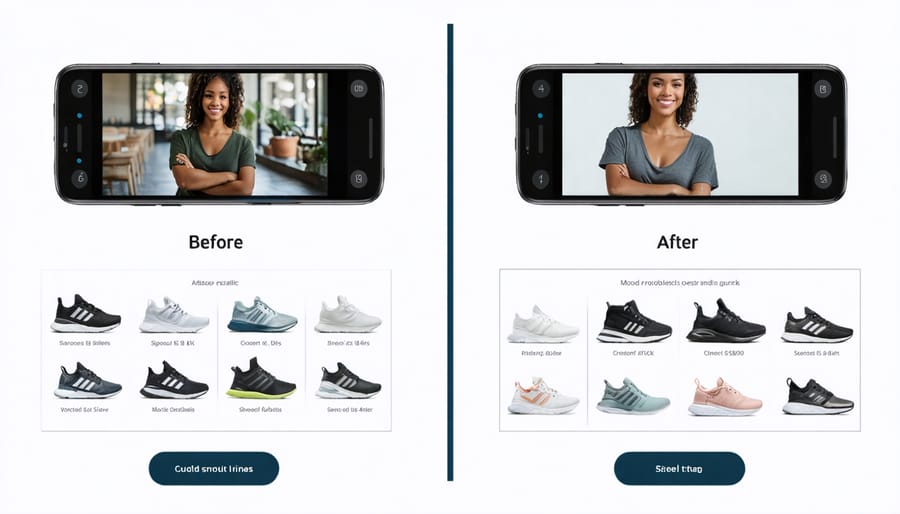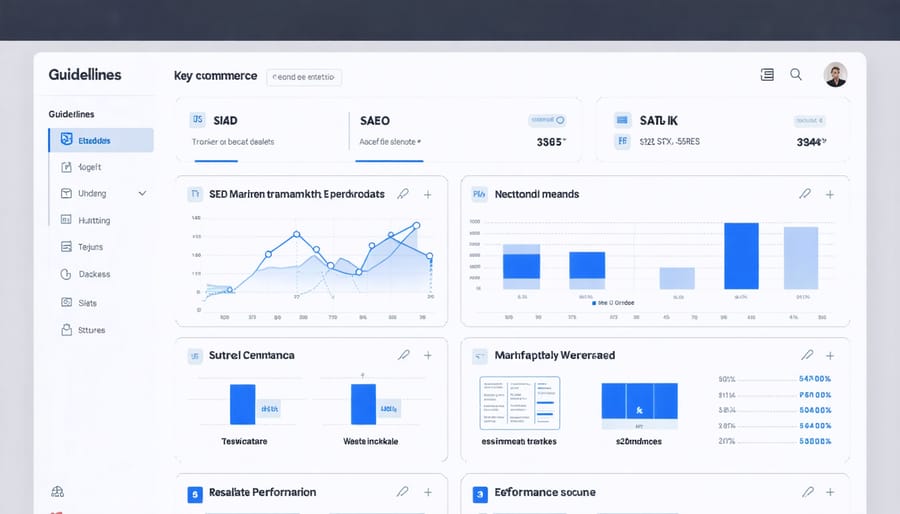Proven SEO Tactics That Drive E-commerce Sales (Updated for 2024)

Transform your e-commerce website into a revenue-generating powerhouse by implementing proven SEO techniques specifically designed for online stores. Optimize product pages with unique descriptions, detailed specifications, and structured data markup to increase visibility in shopping results. Create category-level content hierarchies that target both broad commercial keywords and long-tail purchase-intent phrases. Implement automated inventory management systems that dynamically update meta descriptions, titles, and URLs based on product availability and pricing changes.
E-commerce SEO demands a precise balance between technical optimization and user experience. Establish clear site architecture with logical product categorization, implement faceted navigation without creating duplicate content issues, and ensure mobile-first indexing compatibility across all shopping functions. Regular performance monitoring through enhanced e-commerce tracking reveals which optimization efforts drive the highest conversion rates, allowing for data-driven refinements to your SEO strategy.
Focus on generating authentic user-generated content through customer reviews, Q&A sections, and detailed product guides to build authority and trust signals that search engines reward. This comprehensive approach to e-commerce SEO creates sustainable organic traffic growth while maintaining competitive advantages in increasingly crowded online marketplaces.
Technical SEO Foundations for E-commerce Success
Site Architecture and Navigation
A well-structured e-commerce site architecture is crucial for both user experience and search engine crawling. Start by organizing your products into logical, hierarchical categories that flow from broad to specific. Limit your category depth to no more than three levels to prevent users and search engines from getting lost in deep navigation structures.
For category pages, implement faceted navigation to help customers filter products while ensuring these pages remain crawlable. Include category descriptions that naturally incorporate relevant keywords and provide value to users. Each category page should display products in a grid layout with clear pricing, images, and essential product information.
Product pages need detailed, unique descriptions, high-quality images, clear pricing, and prominent call-to-action buttons. Structure your product information using proper HTML markup and schema data to help search engines understand your content better. Include related products, customer reviews, and technical specifications where applicable.
Internal linking is vital for distributing page authority and helping users discover related products. Create a breadcrumb navigation system to show users their location within your site hierarchy. Cross-link between related products and categories naturally within product descriptions and through “You May Also Like” sections. Ensure your site’s main navigation menu is consistent across all pages and includes your most important category pages.
For large e-commerce sites, implement XML sitemaps separated by content type (products, categories, blog posts) to help search engines discover and index your pages efficiently.

Mobile Optimization and Site Speed
In today’s mobile-first world, your e-commerce site’s performance on smartphones and tablets can make or break your success. Implementing effective mobile speed optimization techniques isn’t just about improving user experience—it’s about securing better search rankings and increasing conversions.
Start by conducting a mobile speed audit using tools like Google’s Mobile-Friendly Test and PageSpeed Insights. Focus on these critical improvements:
1. Image optimization: Compress all product images and implement lazy loading to reduce initial page load times
2. Browser caching: Enable caching to store frequently accessed resources locally
3. Minification: Reduce CSS, JavaScript, and HTML file sizes
4. Content Delivery Network (CDN): Distribute your content across multiple servers globally
5. Accelerated Mobile Pages (AMP): Consider implementing AMP for product pages
Adopting comprehensive mobile-first e-commerce strategies ensures your site performs optimally on all devices. Key areas to address include:
– Responsive design that adapts seamlessly across screen sizes
– Touch-friendly navigation and buttons
– Simplified checkout process optimized for mobile users
– Clear, readable fonts and properly sized content
– Thumb-friendly menu placement and interface elements
Monitor your mobile performance metrics regularly through Google Analytics, focusing on:
– Mobile page load times
– Mobile bounce rates
– Mobile conversion rates
– Time spent on site from mobile devices
Set benchmark goals for these metrics and continuously optimize based on the data. Remember that even a one-second delay in page load time can result in a 7% reduction in conversions, making mobile optimization a crucial element of your e-commerce SEO strategy.

Product Page Optimization
Product Description Excellence
Crafting compelling product descriptions is crucial for achieving high-converting product pages while maintaining strong SEO performance. Start by understanding your target audience’s pain points and search behavior to incorporate relevant keywords naturally into your descriptions.
Follow these essential practices for SEO-friendly product descriptions:
1. Include primary and secondary keywords strategically, focusing on terms your customers actually use when searching for your products.
2. Write unique descriptions for each product, avoiding duplicate content that can harm your search rankings.
3. Structure your content with clear paragraphs, bullet points, and appropriate HTML tags to improve readability and SEO.
4. Front-load important information and keywords in the first few sentences to capture both search engines’ and users’ attention.
5. Incorporate specific product details, measurements, materials, and use cases to provide comprehensive information that answers potential customer questions.
To optimize for conversions:
– Use benefit-driven language that explains how the product solves customer problems
– Include social proof elements like reviews and ratings within the description
– Maintain a consistent brand voice while being descriptive
– Add sensory words to help customers imagine using the product
– Keep sentences concise and easy to scan
Remember to regularly update your product descriptions based on:
– Customer feedback and common questions
– Search term analysis from your analytics
– Seasonal trends and market changes
– Competitor research findings
Implement a systematic approach to description writing by creating templates that ensure consistency while allowing for product-specific customization. This helps maintain quality across your entire catalog while saving time on content creation.
Monitor the performance of your product descriptions through analytics, focusing on metrics like bounce rate, time on page, and conversion rate to continuously refine your approach.
Rich Snippets and Schema Markup
Rich snippets and schema markup are powerful tools that can significantly boost your e-commerce store’s visibility in search results. By implementing product schema correctly, you can help search engines better understand your product information and display enhanced results that attract more clicks.
Product schema markup provides search engines with detailed information about your products, including prices, availability, reviews, and ratings. When implemented correctly, this information appears as rich snippets in search results, making your listings stand out with eye-catching details that can increase click-through rates by up to 30%.
To implement product schema effectively:
1. Include essential product attributes:
– Product name and description
– Price and currency
– Availability status
– Brand information
– Product images
– SKU or unique identifier
– Review and rating data
2. Use the appropriate schema type:
– Product schema for individual items
– Offer schema for pricing and availability
– AggregateRating schema for customer reviews
– BreadcrumbList schema for navigation hierarchy
Ensure your schema markup is properly formatted using JSON-LD, which is Google’s preferred format. Test your implementation using Google’s Rich Results Test tool to verify that your markup is valid and eligible for rich snippets.
Common mistakes to avoid:
– Missing required properties
– Incorrect property values
– Inconsistent information between visible content and schema
– Marking up elements not visible to users
For maximum impact, combine schema markup with high-quality product images, detailed descriptions, and authentic customer reviews. This comprehensive approach not only improves your visibility in search results but also provides potential customers with the information they need to make purchasing decisions.
Remember to regularly update your schema markup to reflect any changes in product information, pricing, or availability. This helps maintain accuracy and trust with both search engines and customers.

Content Strategy for E-commerce
Category Page Content
Category pages are crucial touchpoints in your e-commerce SEO strategy, serving as powerful landing pages that can significantly impact your conversion rates. To optimize these pages effectively, start by conducting thorough keyword research focused on category-level search terms that match user intent.
Structure your category pages with clear hierarchies and intuitive navigation. Place your main category heading in an H1 tag and use descriptive H2 tags for subcategories. Include a compelling category description of 150-300 words above the product grid, incorporating relevant keywords naturally while providing valuable information to shoppers.
Implement faceted navigation to help users filter products, but use robots.txt or meta robots tags to prevent search engines from indexing unnecessary filter combinations. This helps maintain a clean site structure and prevents duplicate content issues.
Optimize your category page URLs to be short, descriptive, and keyword-rich. For example, use “www.yourstore.com/mens-shoes” rather than “www.yourstore.com/category-id-123.”
Consider these essential elements for category page optimization:
– Custom meta titles and descriptions for each category
– Alt text for category images
– Schema markup for breadcrumbs and product listings
– Internal linking between related categories
– Sort options that prioritize popular and high-converting products
– Mobile-friendly layout and fast loading times
Monitor your category page performance through analytics, tracking metrics like bounce rate, time on page, and conversion rate. Use this data to make informed decisions about layout adjustments, product placement, and content updates to continuously improve user experience and search visibility.
Blog and Resource Content
Creating valuable content that supports your product pages is essential for e-commerce SEO success. Start by developing detailed, informative blog posts that address common customer questions and pain points related to your products. These articles should naturally incorporate relevant keywords while providing genuine value to your readers.
Focus on creating buyer’s guides, how-to tutorials, and comparison articles that align with your product categories. For example, if you sell outdoor gear, write comprehensive guides about choosing the right camping equipment or maintaining hiking boots. These content pieces serve dual purposes: they attract organic traffic and support your product pages through internal linking.
Maintain a consistent content calendar that covers seasonal trends and industry updates. This helps establish your store as an authoritative source while keeping your site fresh for search engines. Include user-generated content like customer reviews and testimonials, which not only adds credibility but also provides unique, regularly updated content.
Resource sections should include downloadable content such as size guides, care instructions, or product specifications. These resources improve user experience and increase time spent on your site, both important ranking factors. Consider creating product-specific glossaries or FAQs that target long-tail keywords and address specific customer needs.
Remember to optimize all content with proper heading structures, meta descriptions, and relevant images with alt text. Use internal linking strategically to guide visitors from informational content to related product pages, creating a natural flow through your sales funnel. Regular content audits ensure all pieces remain relevant and continue to serve their intended purpose in your overall SEO strategy.
Automated SEO Monitoring and Maintenance
Performance Tracking
Effective SEO performance tracking is crucial for e-commerce success, requiring consistent monitoring of key metrics and using the right tools to track e-commerce KPIs. Here are the essential metrics to monitor:
Organic Traffic and Conversion Rate
– Total organic sessions
– Product page views from organic search
– Conversion rate from organic traffic
– Average order value from organic visitors
– Revenue attributed to organic search
Technical Performance Metrics
– Page load speed
– Mobile usability scores
– Core Web Vitals
– Crawl stats and index coverage
– Site architecture efficiency
Product Performance Indicators
– Individual product page rankings
– Product click-through rates (CTR)
– Product category performance
– Long-tail keyword rankings
– Product review engagement
Recommended Tools for Tracking:
1. Google Analytics 4 for overall traffic and conversion tracking
2. Google Search Console for search performance and technical issues
3. SEMrush or Ahrefs for keyword tracking and competitor analysis
4. PageSpeed Insights for performance monitoring
5. Screaming Frog for technical SEO audits
Set up monthly performance reviews to analyze these metrics and adjust your strategy accordingly. Focus on identifying trends rather than daily fluctuations, and maintain a dashboard that combines data from multiple sources for comprehensive insights. This systematic approach to tracking ensures your SEO efforts remain targeted and effective while providing clear ROI measurements for your e-commerce business.

Regular Optimization Tasks
Maintaining your e-commerce SEO requires consistent effort, but automation can streamline many routine tasks. Start by implementing a weekly automated site crawl to identify technical issues like broken links, missing meta descriptions, and duplicate content. Tools like Screaming Frog or Sitebulb can be scheduled to run automatically and generate comprehensive reports.
Set up automated performance monitoring through Google Analytics and Google Search Console to track key metrics. Create custom dashboards that monitor organic traffic, conversion rates, and keyword rankings. Configure alerts for significant changes in these metrics to enable quick responses to potential issues.
Product inventory monitoring should be automated to prevent SEO problems caused by out-of-stock items. Implement systems that automatically update product page meta tags and generate 301 redirects for discontinued products. This prevents visitors from landing on dead pages and preserves SEO value.
Establish automated content auditing processes to identify underperforming pages and content gaps. Use tools that analyze page performance metrics and provide recommendations for improvement. Schedule regular content freshness updates to ensure product descriptions and category pages remain relevant.
Price and review monitoring automation is crucial for maintaining accurate rich snippets. Set up systems to regularly check competitor prices and customer reviews, ensuring your schema markup always reflects current data. This helps maintain click-through rates and search result visibility.
Finally, implement automated reporting systems that compile key SEO metrics into digestible formats. Schedule monthly reports that track progress against KPIs and highlight areas needing attention. This ensures stakeholders stay informed while minimizing manual reporting effort.
Implementing effective SEO strategies for your e-commerce store is an ongoing journey that requires dedication, monitoring, and continuous optimization. By following the comprehensive strategies outlined in this guide, you’re well-positioned to improve your store’s visibility and drive more qualified traffic to your products.
Remember to prioritize technical SEO fundamentals, ensuring your site is fast, mobile-friendly, and easily crawlable by search engines. Focus on creating detailed, optimized product descriptions that serve both search engines and potential customers. Maintain a consistent content strategy that addresses your audience’s needs while incorporating relevant keywords naturally.
The key to success lies in taking incremental steps rather than trying to implement everything at once. Start by conducting a thorough SEO audit of your store, then tackle the most pressing issues first. Set up tracking and analytics to monitor your progress, and adjust your strategy based on the data you collect.
Consider automating routine SEO tasks where possible to maintain consistency and save time. This allows you to focus on more strategic initiatives like content creation and user experience improvements. Regular monitoring of your competitors and industry trends will help you stay ahead in the ever-evolving e-commerce landscape.
Take action today by implementing one strategy at a time, measuring its impact, and building upon your successes. With patience and persistence, you’ll see meaningful improvements in your store’s search engine rankings and, ultimately, your bottom line.
Leave a Reply